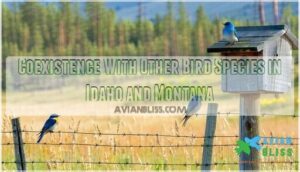This site is supported by our readers. We may earn a commission, at no cost to you, if you purchase through links.

These brilliant blue birds favor open grasslands, meadows, and forest edges at elevations from sea level to 12,000 feet.
In breeding season, they’re most common in Idaho’s high country and Montana’s plains, while winter sends them toward lower elevations and southern ranges.
Oregon and Washington host them primarily during migration and winter months.
Think of them as nature’s nomads—they’re constantly chasing the perfect combination of insects, berries, and suitable nesting cavities, which makes timing vital for spotting these azure gems.
Their range shifts with weather patterns, making it essential to understand their migration habits to catch a glimpse of them.
Table Of Contents
- Key Takeaways
- Mountain Bluebird Habitat and Behavior
- Distribution Range of Mountain Bluebirds in Idaho
- Unique Characteristics of Mountain Bluebirds in Idaho
- Range and Distribution of Mountain Bluebirds in Montana
- Coexistence With Other Bird Species in Idaho and Montana
- Management Considerations for Mountain Bluebirds in Oregon and Washington
- Fire Effects and Use on Mountain Bluebirds’ Habitat
- Frequently Asked Questions (FAQs)
- Which state has the mountain bluebird?
- Is it rare to see a mountain bluebird?
- What is the mountain bird in Idaho?
- Where are mountain bluebirds found in Idaho?
- What states have the mountain bluebird?
- What are the bluebirds of Montana?
- When did the mountain bluebird become the state bird of Idaho?
- What is the average wingspan of Bluebirds?
- What are the common predators of Mountain Bluebirds?
- How can I attract Mountain Bluebirds to my backyard?
- Conclusion
Key Takeaways
- You’ll find mountain bluebirds across seven states (Washington, Oregon, Idaho, Montana, Wyoming, North Dakota, South Dakota), but timing’s critical since they’re seasonal migrants who chase insects and berries between elevations
- They prefer open grasslands, meadows, and forest edges from sea level to 12,000 feet, with Idaho and Montana hosting the densest breeding populations while Oregon and Washington see them mainly during migration and winter
- You’ll spot them perched on fence posts and power lines, hovering like helicopters before diving for insects in summer, then switching to berry-rich juniper bushes during winter flocking behavior
- Fire creates ideal habitat by clearing dense undergrowth and producing dead snags for nesting, while burned areas generate abundant insects that can boost bluebird populations by 40-60%
Mountain Bluebird Habitat and Behavior
Several mountain bluebirds thrive in open landscapes, making their homes across expansive meadows, sagebrush steppes, and high-elevation grasslands.
You’ll spot these social birds perched confidently on fence posts, power lines, and treetops, scanning for their next meal.
Their foraging strategies are quite impressive—they hover like tiny helicopters over open fields before diving down to snatch insects.
This perching behavior combined with their aerial hunting makes them masters of open habitats.
During summer, their insect diet includes beetles, grasshoppers, and caterpillars, while winter flocking helps them efficiently locate berry-rich juniper bushes.
Mountain bluebirds prefer rural ranches and higher elevations for breeding, where bluebird habitat offers plenty of nesting opportunities.
Their foraging behavior shifts seasonally, adapting from insect-heavy summer meals to berry-focused winter diets.
This flexibility guarantees their survival across diverse western landscapes.
Distribution Range of Mountain Bluebirds in Idaho
You’ll find Mountain Bluebirds throughout Idaho’s diverse landscapes, from low valleys at 900 feet to montane zones exceeding 6,500 feet.
These western birds show distinct elevation preferences, concentrating in southern and central Idaho’s grasslands and the Snake River Plain during breeding season.
Idaho Bluebird Hotspots include southwestern regions near the Owyhee Mountains and Camas Prairie, where densities reach 12 pairs per square kilometer in managed areas.
The mountain bluebird population peaks along shrub-steppe margins and agricultural field edges, avoiding heavily forested northern panhandle zones.
Seasonal movement patterns reveal fascinating climate impacts on this Idaho fauna.
Birds arrive in southern valleys by February-March, spreading to higher elevations through April.
Most migrate south by October, though some winter in southern Idaho during mild years.
Habitat fragmentation from sagebrush conversion poses ongoing challenges, but wintering locations in protected riparian corridors help sustain populations across Idaho’s bluebird habitat.
Unique Characteristics of Mountain Bluebirds in Idaho
Within Idaho’s rugged terrain, mountain bluebirds display remarkable adaptations that set them apart from their Western Bluebirds cousins.
These sky-blue gems showcase unique Idaho plumage patterns, with males sporting vibrant electric-blue coloring that’s particularly striking against sagebrush landscapes. Their Idaho size averages slightly larger than populations in neighboring states, likely due to abundant high-altitude resources.
Key Idaho adaptations include:
- Cold tolerance – They remain active even after late spring snows hit mountain meadows
- Flexible foraging – Their Idaho diet shifts from flying insects to ground beetles during windy conditions
- High-altitude nesting – They’ll nest up to 2,200 meters, higher than most songbirds
Idaho’s variable spring weather often limits these birds to single broods annually, unlike populations elsewhere. Their shortened breeding window demands strategic nest box placement in protected areas.
Mountain bluebirds often nest in abandoned flicker holes, if available. Idaho genetics show regional song dialects among isolated populations, suggesting local adaptation.
While Idaho longevity data remains limited, harsh winters can impact survival rates substantially.
Range and Distribution of Mountain Bluebirds in Montana
Montana’s Mountain Bluebird populations showcase remarkable seasonal patterns across the state’s diverse landscapes.
You’ll spot these Rocky Mountain birds from late March through October, with peak activity during breeding season from April to July.
Montana habitats range from prairie edges in the east to mountain valleys in the west, with elevation factors playing a key role – most birds prefer areas between 2,500 and 7,500 feet.
Breeding grounds concentrate heavily in the Bitterroot Valley, Gallatin Valley, and Rocky Mountain Front, where montane meadows provide ideal nesting conditions.
Eastern Montana’s agricultural edges support extensive populations too.
Migration routes bring 45,000 to 75,000 birds annually to the state’s breeding grounds, making them one of Montana’s most common cavity nesters.
Winter finds few stragglers in mild valley regions, though most follow migration routes south to wintering areas in lower elevations.
Fire-restored landscapes have boosted habitat availability substantially.
Coexistence With Other Bird Species in Idaho and Montana
When Mountain Bluebirds call Idaho and Montana home, they’re not flying solo—they share their territory with numerous other species through complex ecological relationships.
Resource partitioning helps these birds avoid direct confrontation by using different hunting strategies and perching heights.
In both states, you’ll witness fascinating interspecies dynamics:
- Nesting site competition intensifies with Tree Swallows occupying up to 62% of available nest boxes in Montana
- Habitat overlap occurs with Western Meadowlarks and Tree Swallows in grasslands and pastures
- Interspecies flocking during winter creates mixed-species groups around juniper bushes for berry foraging
- Predator avoidance benefits from Western Kingbirds and Cliff Swallows acting as early warning systems
- Resource partitioning reduces direct competition through elevated perch preferences versus ground-foraging sparrows
Habitat competition remains fierce, especially with European Starlings and House Wrens.
However, bluebirds gain competitive advantages by initiating breeding several weeks earlier than most competitors, securing prime nest site preferences before migratory species arrive in Wyoming and Montana’s high-elevation territories.
Management Considerations for Mountain Bluebirds in Oregon and Washington
You’ll find that managing mountain bluebirds in Oregon and Washington requires balancing their needs with competing wildlife and changing landscapes.
These strategies focus on three critical areas: preserving suitable habitat, reducing nesting competition, and tracking their seasonal movements across elevation gradients.
Habitat Preservation Strategies
You’ll strengthen Mountain Bluebird populations by protecting snags during timber operations—these dead trees are prime real estate for cavity nesters.
Install nest box programs where natural cavities are scarce, and maintain native plants through smart rangeland practices.
Let burned areas regenerate naturally since fire management creates ideal foraging habitat.
These habitat preservation efforts support successful bluebird conservation and reintroduction efforts.
Snag retention strategies are essential for bluebird nesting sites and aid habitat restoration.
Nesting Site Competition
Throughout Oregon and Washington, you’ll face serious nestsite competition from invasive species like European starlings and house sparrows.
These aggressive competitors destroy bluebird eggs in up to 30% of nest boxes. Tree swallow competition can claim over half your available nest sites, while flicker competition intensifies pressure on natural cavities.
Proper nest box design with 1.5-inch entries helps reduce intrusions. Snag preservation remains vital—removing dead trees cuts cavity nesting options by 70%, making nest boxes essential compensation in managed forests.
You may want to examine different nest box materials for ideal insulation.
Seasonal Migration Patterns
Beyond nesting challenges, you’ll want to track these birds’ impressive journeys across your region.
Mountain Bluebirds follow predictable Migration Routes, with bird migration timing influenced by Migration Triggers like daylight and temperature changes.
Here’s their annual cycle of migration:
- Pre-breeding migration: February to April, when birds return to establish breeding territories in higher elevations
- Breeding season: Late April through August in eastern Washington and Oregon’s mountain areas
- Post-breeding migration: September to November, as families move toward Wintering Habitats at lower elevations
- Year-round residents: Central Oregon and southwest Idaho populations that don’t migrate far
Climate Impacts increasingly affect these seasonal migration patterns, making monitoring seasonal migration patterns essential for conservation.
Stopover Ecology research shows these birds need reliable food sources during their travels between summer and winter homes.
Fire Effects and Use on Mountain Bluebirds’ Habitat
Fire Benefits are game-changers for mountain bluebirds. You’ll find that prescribed burns create the open, park-like conditions these birds crave by clearing dense undergrowth and shrubs. Think of fire as nature’s landscaper – it transforms cluttered forests into prime bluebird real estate.
Burned Snags become goldmines for nesting. These standing dead trees provide perfect cavities while Post-fire Insects like beetles and grasshoppers multiply rapidly, creating an all-you-can-eat buffet for hungry chicks. Studies show bluebird populations can surge 40-60% in burned areas.
However, severe wildfires pose risks to active nests. Smart Fire Management balances benefits with protection. Land managers should let naturally burned areas regenerate without salvage logging.
Understanding these complex fire regimes and their fire effects helps maintain healthy bluebird populations across the Northwest. Habitat Regeneration following fires supports long-term conservation success.
Frequently Asked Questions (FAQs)
Which state has the mountain bluebird?
You’ll find mountain bluebirds calling seven states home: Washington, Oregon, Idaho, Montana, Wyoming, North Dakota, and South Dakota.
They’re native breeders across this western territory, thriving in open country and high elevations.
Is it rare to see a mountain bluebird?
Like spotting a sapphire in the sky, you’ll find mountain bluebirds aren’t exactly rare across their western range.
They’re common summer residents in open, high-elevation areas, though you’ll need patience and binoculars to catch sight of these hovering beauties.
What is the mountain bird in Idaho?
You’ll spot Mountain Bluebirds throughout Idaho’s open country, especially in sagebrush steppe, meadows, and high elevations up to 12,000 feet.
They’re common summer residents that migrate to lower elevations during winter months, making them a notable sight in various elevations.
Where are mountain bluebirds found in Idaho?
Blue wings against endless sky mirror hope itself—you’ll discover these aerial gems throughout Idaho’s high country.
From sagebrush steppes to mountain meadows, nesting in cavities and hunting insects across open terrain.
What states have the mountain bluebird?
You’ll encounter mountain bluebirds across eight western states: Washington, Oregon, Idaho, Montana, Wyoming, North Dakota, and South Dakota. They breed throughout these regions’ open country and higher elevations.
What are the bluebirds of Montana?
Contrary to popular belief that all bluebirds look identical, you’ll find three distinct species in Montana.
Mountain Bluebirds dominate with their electric-blue males and gray-blue females, while Western and Eastern Bluebirds occasionally appear during migration periods.
When did the mountain bluebird become the state bird of Idaho?
You’ll learn something neat here: Idaho adopted the mountain bluebird as its official state bird on February 28, 1931, when the legislature made this vibrant blue beauty their symbol of hope and happiness.
It shares this honor with Nevada, which also recognizes it as a state symbol.
What is the average wingspan of Bluebirds?
You’ll find a Mountain Bluebird’s wingspan stretches 0-2 inches on average.
That’s roughly the span of your hand plus a few fingers – perfect for their hovering hunting style over open fields.
What are the common predators of Mountain Bluebirds?
When your neighbor’s cat caught a bluebird near her nest box, you witnessed nature’s reality.
House cats and raccoons pose major threats, while deer mice, chipmunks, and tree-climbing snakes also prey on eggs and nestlings.
How can I attract Mountain Bluebirds to my backyard?
Install nest boxes 5-8 feet high in open areas with scattered trees.
Provide water sources and berry-producing plants like juniper.
Avoid pesticides, and maintain open grassland habitat where they can hunt insects effectively.
Conclusion
Remarkably, mountain bluebird populations thrive when fire and conservation efforts align—coincidentally creating the exact open habitats these birds need.
You’ll find mountain bluebird populations in Washington, Oregon, Idaho, Montana, Wyoming, and both Dakota states by understanding their seasonal patterns and elevation preferences.
Success depends on timing your observations with their migration cycles, protecting nesting sites, and supporting habitat management that maintains the grassland-forest edge balance these brilliant blue nomads require for survival.








